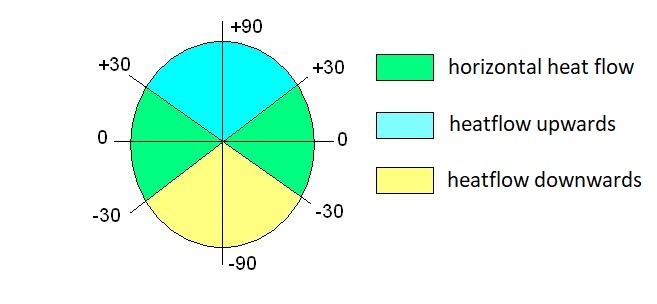Use of the surface resistance calculator
1 Selecting a surface type

The surface resistance refers to surfaces that are in direct contact with the air and affect the U-value of the external envelope. Surface resistance depends on the direction of heat flow, the surface temperature, the emissivity of the surface and, for external surfaces, the wind speed. The first step is to choose whether the surface is internal (warm) or external (cold) and to specify the direction of the heat flow.
Typically, the direction of heat flow in walls is horizontal, but this also includes heat flows that make an angle of +/- 30º with the horizontal plane. But it may also include, for example, a roof with a steep pitch, e.g. a mansard, if the pitch of the roof exceeds 60º.
Typically, in the case of roofs and upper floors, the direction of heat flow is upwards, but this also includes heat flows that form an angle of +30º to +90º with the horizontal plane. This category therefore includes roofs with a pitch of less than 60º.
Typically, the direction of heat flow is downward for slab-on-ground floors, suspended ground floors and basement floors, but this also includes heat flows that form an angle of -30º to -90º with the horizontal plane.

In the case of an external surface, it is also important whether the external surface is in direct contact with the external airspace or with a well-ventilated air gap (e.g. a ventilated façade cladding). A well-ventilated air gap is one where the surface area of the ventilation openings is greater than 1500 mm2 per horizontal flow metre for vertical air gaps, e.g. walls, or greater than 1500 mm2 / m2 roof surface area for horizontal air gaps, e.g. roofs.
2 Surface temperature

The surface resistance depends on the surface temperature. By default, the outside temperature is considered to be +10ºC and the inside temperature +20ºC.
3 Surface emissivity

The surface resistance also depends on the emissivity of the surface. The basic value for general building materials is 90%. By using special materials, e.g. aluminium foil facing (3-5%), low emissivity coating (15-25%), the emissivity can be reduced and thus the surface resistance can be increased, thus improving the thermal insulation performance.
4 Wind speed

For external surfaces, the surface resistance also depends on the wind speed. The standard default wind speed is 4 m/s. If the wind speed decreases, the surface resistance increases and the thermal insulation capacity improves.

